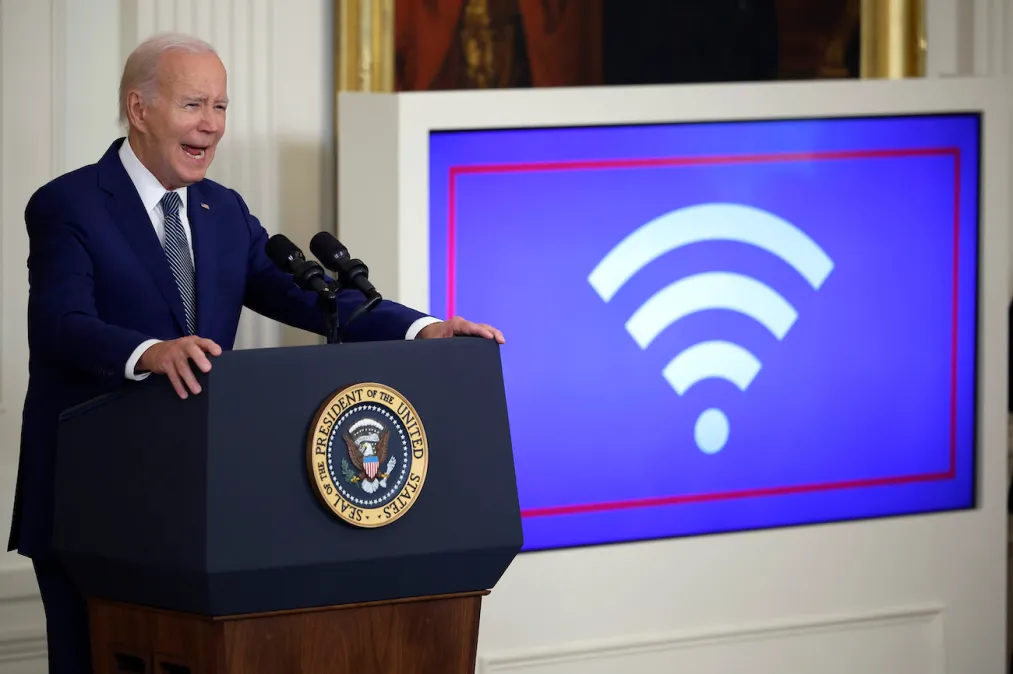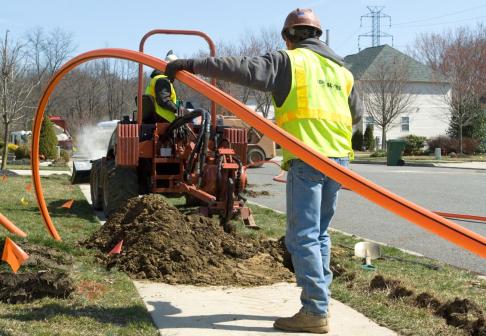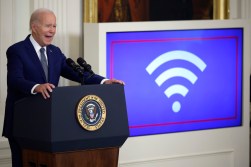Biden announces $42.5B in broadband funds from BEAD program

President Joe Biden and Vice President Kamala Harris announced Monday how nearly $42.5 billion in Broadband, Equity, Access and Deployment funds will be divided among states and territories, marking the federal government’s single-biggest investment in high-speed internet access.
Speaking at the White House on Monday, Biden said the goal of connecting all Americans to high-speed internet is “bold” but “there’s nothing beyond our capacity.”
In addition to highlighting the importance of the Affordable Connectivity Program — an FCC-run initiative that is not guaranteed continued funding beyond early 2024 — Biden emphasized the role of the BEAD funding in creating new jobs for Americans, stressing that cable used in BEAD projects would be American-made.
The BEAD allocations have been a long time coming, with states waiting for months to learn exactly how much funding they will receive from the $42.45 billion program — the crown jewel in the Biden administration’s “Internet for All” agenda.
Between 2021’s American Rescue Plan and Infrastructure Investment and Jobs Act, which included the BEAD program, the federal government has created $90 billion in new funding for high-speed internet.
The BEAD allocations were largely in line with expectations, Tyler Cooper, editor-in-chief of BroadbandNow, said in an interview. “There weren’t any shockers,” he said.
Texas, with an allocation of more than $3.3 billion, far outpaced any other state in terms of funding — but Cooper, a Texas resident himself, said that was to be expected.
“The size of Texas is kind of hard to grasp if you didn’t grow up here. It’s massive,” he said. “Much of the population is centered around these few central urban hubs, but then we have this massive swath of small towns spreading across the topography of Texas with infrastructure that is lacking. There’s a lot of copper infrastructure here, and not a lot of fiber, outside of the major hubs.”
Cooper also said Biden’s announcement kicked off what will a “long marathon” with states taking diverse approaches to how they parcel out their funding.
“I think it goes without saying that Texas and California are going to have drastically different approaches to how they use this funding pool,” he said. Texas’ “private-sector first” approach, he said, suggests a strategy that’ll favor existing internet carriers. He also anticipated a divide among states on using BEAD funding to support municipal broadband networks.
During a conference call with reporters last week, White House Chief of Staff Jeff Zients compared Biden’s BEAD funding announcement to President Franklin Roosevelt’s 1936 Rural Electrification Act — legislation that delivered electricity to every farming family in America and is now known as “the night the lights came on,” he said.
“I think it’s fair to say [that legislation] helped transform rural America, and importantly demonstrated that government can get things down for people,” Zients said. “Fast forward nine decades later, under President Biden’s leadership, the infamous infrastructure week, or infrastructure month, has finally become a reality.”
Internet access is no longer a “nice-to-have” but a “must-have” and “the President knows that,” Zients said. “That’s why on Monday, President Biden will kick off the second leg of the Invest in America tour by announcing the largest internet funding ever, so that everyone can have affordable, reliable, high-speed internet access.”
The BEAD announcement is part of a three-week blitz by the Biden administration promoting programs funded by the Rescue Plan and infrastructure law. On Monday, Biden and Harris are expected to say that every state, as well as Washington, D.C. and Puerto Rico, stand to receive at least $100 million.
The Department of Commerce’s National Telecommunications and Information Administration, which is running the BEAD grant fund, determined each state’s allocation based on national broadband availability maps created by the Federal Communications Commission.
The accuracy of the FCC maps has been called into question, but senior administration officials said Friday that these maps have been instrumental in determining where high-speed internet access is available in the U.S. and where it is not. The first version of the map was published in November, followed by a period in which states, internet carriers and other parties were able to challenge the accuracy of the underlying data. The second version — which the NTIA used to determine where BEAD funds should be focused — was published May 30.
“According to the most up-to-date version of the FCC’s map, there are 8.5 million locations in the United States and its territories where high speed internet service is not available,” a senior administration official said on Friday’s call. “That is about 7% of our country. As a point of comparison, prior maps which were much much less granular had the problem pegged at 2%.”
Once states are notified of their BEAD allocation, they will have six months to submit initial proposals covering how they plan to spend the funds.
“In order to do that, we will see a very public planning process play out in each state as each state is required to do local coordination with their county and local governments,” a senior official said. “Each state is also permitted under the rules to run their own challenge process to their own state map to make sure that any additional corrections that need to take place occur.”
Once the NTIA approves states’ initial plans, states will be able to access up to 20% of their funds. States will then run competitive sub-granting processes before submitting their final plans to the NTIA for approval in spring 2025 and receiving the remaining 80% of their allocations.





